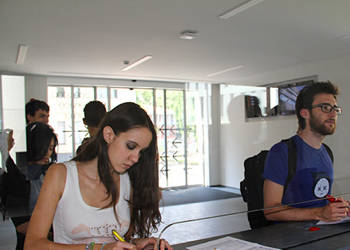20844 - DESIGN THINKING AND BUSINESS INNOVATION
Course taught in English
Go to class group/s: 31
Synchronous Blended: Lessons in synchronous mode in the classroom (for a maximum of one hour per credit in remote mode)
The course enables students to understand what a digital start up is, how it differs from more traditional companies, and its major challenges and how to approach them. To facilitate this objective, it will rely on case studies illustrating the emergence and the evolution of digital start-ups. Another primary goal of the course is to push students to grasp the key entrepreneurial drivers of success and failure in the digital age, raising relevant questions and developing possible answers. The course will also leverage on the presence of external speakers in class, who will share their experiences and discuss both the innovation and entrepreneurial aspects of digital start-ups. Moreover, the class will be divided in teams to provide additional hands-on experience to students. The final team project will be evaluated at the end of the course by both industry experts and faculty.
The course develops around two main themes.
Digital start-ups
- Definition of a digital start-up and its key characteristics.
- Critical elements in a digital start-up.
- Different phases and challenges in a digital start-up’s life.
Digital entrepreneurship and digital transformation
- The difference between digitalization processes and digital transformation.
- Definition of entrepreneurship in the digital era and its implications.
- Corporate entrepreneurship: how big firms inbreed a start-up’s culture
- Identify digital start-ups and their main features.
- Understand the different phases faced by a digital start-up.
- Understand the main challenges and risks of entrepreneurship in the digital age and the different strategies available to approach them.
- Recognize the key entrepreneurial drivers of success or failure in digital start-ups.
- Understand digital start-ups according to the framework developed during the course.
- Recognize threats and opportunities brought by the digital age.
- Exploit digital tools to come up with innovative solutions to existing problems.
- Think strategically within the context of rapidly evolving digital businesses.
- Face-to-face lectures
- Guest speaker's talks (in class or in distance)
- Case studies /Incidents (traditional, online)
- Group assignments
Business cases are discussed to identify theoretical frameworks from real situations, therefore students are expected to read the assigned cases prior to the related sessions so to engage in active discussions in the class. Students will take part in a team project that will require them to develop a business idea in the digital domain and some key elements of the business plan.
In addition to face-to-face lectures, case studies, and interactive class activities, we expect to have guest speakers to share their experiences on digital entrepreneurship.
| Continuous assessment | Partial exams | General exam | |
|---|---|---|---|
| x | |||
| x |
Interaction is key to maximize learning within the course. Attendance is recommended and class interaction and participation will be evaluated. Students are also required to take part in a team project which will make up part of the final grade. A final written exam will evaluate students' overall understanding of the topics. The final grade will be computed as follows:
- Team project (70%)
- Written exam (30%)
Class participation will be evaluated at the team level. Students are expected to divide into self-formed teams of 3 to 5 students. Each team needs to pick a name and elect a team spokesman, to whom the instructors will address any specific communication. During the course, the instructors will evaluate class participation based on the voluntary contribution of teams to class discussion.
Design Thinking is a dynamic and innovative problem-solving approach that empowers individuals to address complex challenges creatively. Students embark on a transformative journey that goes beyond conventional problem-solving methodologies. The primary learning purposes and outcomes from such a course are:
1. Creative Problem Solving. Learning Purpose: Design Thinking equips students with the ability to approach problems with a creative mindset.
Teamwork and final Exam Assessment: Students can be evaluated based on their capacity to generate unique solutions, demonstrating a departure from traditional problem-solving approaches.
2. Empathy and Human-Centric Solutions. Learning Purpose: Design Thinking emphasizes understanding and empathizing with end-users to create solutions that truly meet their needs.
Teamwork and final Exam Assessment. Evaluation may include assessing how well students integrate user perspectives into their proposed solutions and whether empathy is a driving force in their designs.
3. Collaboration and Interdisciplinary Skills. Learning Purpose: Design Thinking fosters collaboration, encouraging students to work effectively in interdisciplinary teams.
Teamwork and final Exam Assessment: Students can be evaluated on their ability to collaborate, communicate, and integrate diverse perspectives into their design processes.
4. Iterative Prototyping. Learning Purpose: Iterative prototyping is a key aspect, allowing students to refine and improve their solutions through continuous feedback.
Teamwork and final Exam Assessment: Students might be assessed on their iterative approach, understanding how well they incorporate feedback and evolve their designs over successive iterations.
5. User Feedback Incorporation. Learning Purpose: Design Thinking teaches students to value user feedback as a crucial component of the design process.
Teamwork and final Exam Assessment: Evaluation could focus on the effectiveness of students' mechanisms for gathering user feedback and their demonstrated commitment to refining designs based on this feedback.
6. Complex Problem Decomposition. Learning Purpose: Design Thinking involves breaking down complex problems into manageable components for analysis.
Teamwork and final Exam Assessment: Students can be assessed on their ability to deconstruct complex challenges, identifying key elements and relationships in a given problem.
7. Communication of Design Concepts. Learning Purpose: Design Thinking emphasizes the importance of clear and compelling communication of design concepts.
Teamwork and final Exam Assessment: Evaluation may include assessing students' presentations, reports, or visualizations, focusing on how well they communicate their ideas to various stakeholders.
8. Innovative Mindset Cultivation. Learning Purpose: Design Thinking instills an innovative mindset, encouraging students to embrace ambiguity and pursue novel ideas.
Teamwork and final Exam Assessment: Students can be evaluated on their demonstrated willingness to explore unconventional solutions and their ability to navigate uncertainty.
In the final written exam, questions can be designed to assess these specific learning outcomes, ensuring that students not only grasp the theoretical concepts of Design Thinking but can also apply them in practical problem-solving scenarios, allowing students to showcase their acquired skills and understanding of Design Thinking principles.
Assessment of non-attending students is based on an individual project (50%) and a final written exam (50%) that probes the student’s understanding of the concepts inherent to the methodology of Design Thinking.
Design Thinking is a dynamic and innovative problem-solving approach that empowers individuals to address complex challenges creatively. Students embark on a transformative journey that goes beyond conventional problem-solving methodologies. The primary learning purposes and outcomes from such a course are:
1. Creative Problem Solving. Learning Purpose: Design Thinking equips students with the ability to approach problems with a creative mindset.
Teamwork and final Exam Assessment: Students can be evaluated based on their capacity to generate unique solutions, demonstrating a departure from traditional problem-solving approaches.
2. Empathy and Human-Centric Solutions. Learning Purpose: Design Thinking emphasizes understanding and empathizing with end-users to create solutions that truly meet their needs.
Teamwork and final Exam Assessment. Evaluation may include assessing how well students integrate user perspectives into their proposed solutions and whether empathy is a driving force in their designs.
3. Collaboration and Interdisciplinary Skills. Learning Purpose: Design Thinking fosters collaboration, encouraging students to work effectively in interdisciplinary teams.
Teamwork and final Exam Assessment: Students can be evaluated on their ability to collaborate, communicate, and integrate diverse perspectives into their design processes.
4. Iterative Prototyping. Learning Purpose: Iterative prototyping is a key aspect, allowing students to refine and improve their solutions through continuous feedback.
Teamwork and final Exam Assessment: Students might be assessed on their iterative approach, understanding how well they incorporate feedback and evolve their designs over successive iterations.
5. User Feedback Incorporation. Learning Purpose: Design Thinking teaches students to value user feedback as a crucial component of the design process.
Teamwork and final Exam Assessment: Evaluation could focus on the effectiveness of students' mechanisms for gathering user feedback and their demonstrated commitment to refining designs based on this feedback.
6. Complex Problem Decomposition. Learning Purpose: Design Thinking involves breaking down complex problems into manageable components for analysis.
Teamwork and final Exam Assessment: Students can be assessed on their ability to deconstruct complex challenges, identifying key elements and relationships in a given problem.
7. Communication of Design Concepts. Learning Purpose: Design Thinking emphasizes the importance of clear and compelling communication of design concepts.
Teamwork and final Exam Assessment: Evaluation may include assessing students' presentations, reports, or visualizations, focusing on how well they communicate their ideas to various stakeholders.
8. Innovative Mindset Cultivation. Learning Purpose: Design Thinking instills an innovative mindset, encouraging students to embrace ambiguity and pursue novel ideas.
Teamwork and final Exam Assessment: Students can be evaluated on their demonstrated willingness to explore unconventional solutions and their ability to navigate uncertainty.
In the final written exam, questions can be designed to assess these specific learning outcomes, ensuring that students not only grasp the theoretical concepts of Design Thinking but can also apply them in practical problem-solving scenarios, allowing students to showcase their acquired skills and understanding of Design Thinking principles.
- Handouts distributed throughout the course.
- Cases as in the syllabus.
- Readings as in the syllabus.
- Suggested reading: the textbook will be communicated at the beginning of the course.
- The textbook will be communicated at the beginning of the course (it is mandatory and will substitute for Handout materials).
- Cases as in the syllabus.
- Readings as in the syllabus.





